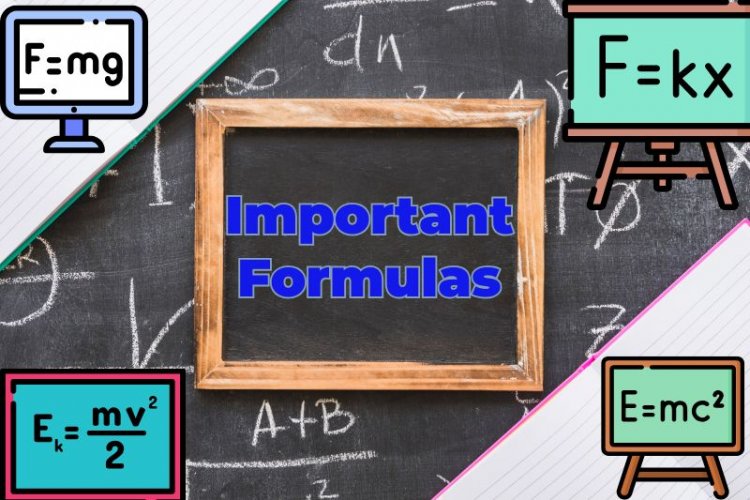Important Formulas
Physics uses fundamental formulas to measure objects, including speed, distance, velocity, density, energy, and force.

Basic Physics Formulas:
Physics is all about expressing the objects with actual values rather than memorization. Numerous ideas, issues, and mathematical formulas could appear throughout the applications. For us to overcome complications, we need to leverage our capability, inventiveness, and any similar potential. Here are some fundamental physics formulas with illustrations.
1)Speed:
It is used to determine the average speed of a moving body or both the time and the path covered.
S = d/t
Where
S average speed
d total distance
t duration taken
It is measured in meters per second (m/s) in the S.I.
2)Distance:
Use the distance calculation equation
d = st
which reads "distance equals speed times "t"," to find "d".
The above equation can be used to determine the missing value if the two numbers for distance, speed, or time are known.
3) Velocity:
The amount of displacement of a body in a time is referred to as velocity.
v=d/t
Where
v velocity
d a distance the object traveled
t duration of the event
In S.I. velocity is taken as m/s.
A vector quantity with both magnitude and direction is velocity.
4) Acceleration:
The rate at which velocity varies with "t" is referred to as "acceleration."
a=v/t
or a=v-u/t
Here
v final velocity
u initial velocity
t total interval
In S.I., acceleration is a meter per square second (m/s2).
Due to its magnitude and direction, acceleration is also a vector.
5) Density:
The amount of anything per unit area, length, or volume, or the mass of a material per unit volume.
ρ=m/V
In S.I. density is taken as kg/m^3.
The scalar quantity of density is denoted by the symbol rho ( ρ), as it has no direction.
6) Energy:
Energy is the ability to do tasks. It may exist in several forms, including potential, kinetic, thermal, electrical, chemical, radioactive, and others.
7) Power:
The ability to carry out a task is referred to as energy. On the other side, power can be defined as the quantity of energy spent in a given period of "t" when acting.
P=W/t
Watt (W), which is derived from joule per second (J/s), is the SI unit of power. Horsepower (hp), which is roughly equivalent to 745.7 watts, is a standard of measurement commonly used to describe the power of automobiles and other devices.
8) Force:
A push or pull that causes acceleration in the body it operates on is called a force.
F=ma
where
F common symbol of force
m mass of an object
In S.I. it is expressed as Newton.
In the S.I base, it is kg.m/s2
It is a vector.
9) Weight:
Weight is nothing more than the force that gravitation applies to an object.
W=mg
Here
W weight
m mas of the body
g acceleration due to gravity
In SI, weight in kilograms is multiplied by meters per second squared, or kgm/s2, which is equal to a Newton (N).
What type of quantity?
A body's weight is a measurement of the gravitational force acting on it. We know that an "F" has both magnitude and direction and since we refer to it as the vector, we can infer that weight is also a vector.
10) Pressure:
The amount of "F" applied per unit area of a body is referred to as the "pressure."
P=F/A
Here
P pressure
F force applied
A total area
The International System of Measurements (SI) uses the Pascal (Pa) as the measure of stress or pressure. Blaise Pascal, the mathematician, and physicist, is honoured by his name. One newton (N) of force approximately equates to 1 pascal (P), exerted across a surface area of 1 square meter (m2).
11) Frequency:
The number of cycles of the wave and the number of complete rotations per second are both terms for frequency.
f=v/λ
Where
f frequency of the wave
v wave speed
λ The wavelength of a wave
The hertz (Hz) is the SI standard of frequency. A hertz equals a cycle every second. A scalar quantity is a frequency.
12)Formula for Fahrenheit:
It is an equation for temperature conversion.
F = (9.5 °C) + 32
13)Calculating Torque:
The rotating force or effect of turning is known as torque.
T = F r sinθ
14)Pendulum:
The time it takes the pendulum to swing back and forth in seconds can be calculated using this formula. It is one of the formulas from basic physics that is utilized the most.
T = 2π√Lg
15)Mass:
The link between "F" and mass is shown by the mass formula.
F=ma or m=F/m
16)Ohm's law:
The Ohms law, one of the most famous laws in basic physics, states that the current (I) flowing through a conductor item is directly proportional to the potential difference between its two terminals.
V=IR
17)Displacement:
Displacement is the shift in an object's location from its initial position to its ultimate position.
D = Xf-Xi = ΔX
What's Your Reaction?



















